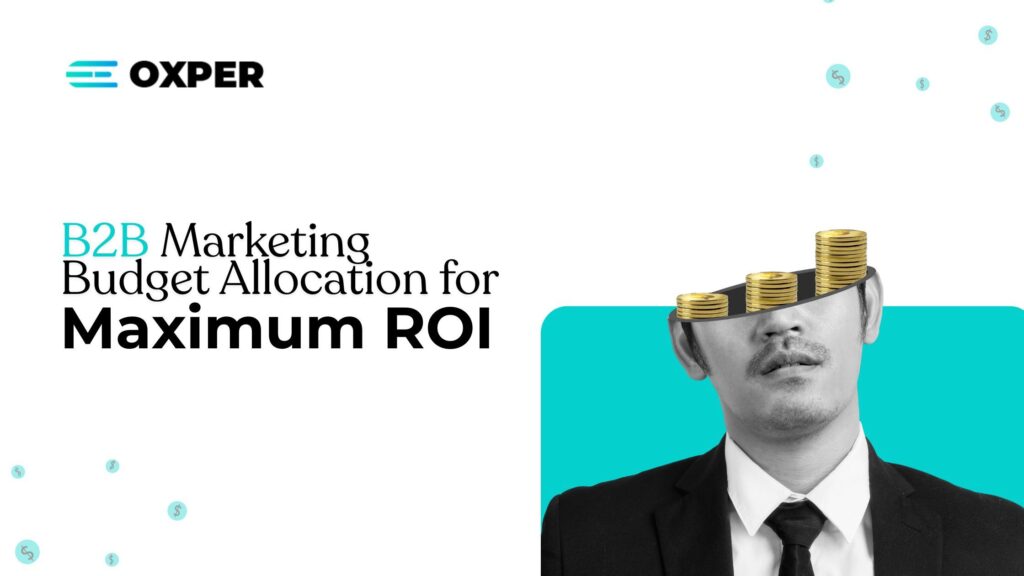Are you trying to maximize marketing ROI but unsure how to distribute your B2B marketing budget effectively? You’re not alone. As marketing leaders gear up for 2025, getting the right digital marketing ROI means making smart, insight-driven budget allocations. From campaign planning to automation tools, this guide walks you through how to get the most out of every dollar you spend. Let’s break down the budget, the channels, and the ROI math so you can scale smartly and stay ahead.
How to Think About ROI in Digital Marketing
Think of your B2B marketing budget like a pie. Everyone wants a slice, but not all slices return equal value. Your role as a decision-maker isn’t to keep everyone happy—it’s to deliver impact. So how much of your marketing budget is enough to generate real ROI? Let’s explore how to make smart financial decisions that drive meaningful results.
Putting Every Penny to Work: A Quick Cost Benchmark
According to industry norms:
- New B2B companies trying to scale fast should spend 12% to 20% of gross revenue on marketing.
- Mature B2B organizations focused on efficiency may aim for 8% to 12%.
With that in mind, if your company generates $10M in annual revenue, your marketing budget could range from $800,000 to $2,000,000, depending on growth goals.
Benchmark Your Industry Peers
Before finalizing allocations, analyze how your direct competitors and category leaders are spending. Use tools like Semrush, SimilarWeb, or financial reports of public competitors to assess:
- The mix of digital vs. traditional channels
- Content cadence and engagement rates
- Paid ad presence across platforms
Understanding their spend can help you spot oversaturated areas and identify whitespace opportunities to get better digital marketing ROI.
Set Clear Goals & Reverse-Engineer Your Budget
Budgeting should start with the end in mind. Work backward from your business goals to determine what kind of marketing activity is needed. Focus on these key business metrics:
- Average Contract Value (ACV): The higher the ACV, the more you can afford to spend per lead.
- Close Rate: Knowing how many MQLs convert to revenue helps define how many leads you need.
- Revenue Goals: Break down your annual revenue target into a marketing contribution percentage.
From this model, you can determine how much to invest to deliver the volume and quality of leads required.
B2B Marketing Budget Breakdown for 2025 & Beyond
Let’s assume your total marketing budget is $1,000,000. Here’s a recommended allocation strategy that balances performance, brand building, and operational efficiency:
- Campaign Planning & Content Creation: $400,000 to $500,000 Content remains king. Invest nearly half of your budget in high-performing assets such as blogs, videos, whitepapers, and case studies. This also includes strategy, SEO, and creative production.
- Paid Advertising: $200,000 to $300,000 Fuel your inbound and ABM (Account-Based Marketing) strategy with targeted ads. Platforms like LinkedIn, Google Ads, and intent-based platforms can deliver strong ROI when tracked closely.
- Workforce Marketing: $100,000 Use internal programs and enablement tools to build a unified employee brand voice. This includes internal branding, training, and event costs for sales enablement.
- Tools & Automation: $100,000 Invest in marketing tech that improves workflows, data capture, attribution modeling, and personalization. Choose platforms like HubSpot, Salesforce, or Marketo that show measurable returns.
- Events (Trade Shows, Conferences, Hosted Webinars): $50,000 to $100,000 Use events to reinforce thought leadership and deepen relationships with prospects. Virtual or in-person, they provide excellent content and lead-generation opportunities.
High-ROI Channels to Prioritize in 2025
Don’t spread yourself thin. Based on trends and research, here are the digital marketing channels expected to yield the highest ROI in 2025:
- SEO & Content Marketing: Long-term organic lead gen with compounding results
- LinkedIn Ads & Thought Leadership: Prime for B2B visibility
- Email Marketing: One of the highest ROI channels when used for nurture & ABM
- Webinars & Podcasts: Scalable authority-building content
- Retargeting Campaigns: Keep high-intent leads in your funnel
- Influencer & Industry Partnerships: Use trusted voices in niche segments
- Conversion Rate Optimization (CRO): Don’t just drive traffic, convert it
Frequently Asked Questions (FAQs)
Q: What is the 70-20-10 rule in marketing budgets?
A: It refers to allocating 70% to proven strategies, 20% to new but promising ideas, and 10% to experimental tactics that carry some risk but could unlock major rewards.
Q: How much of my advertising budget should go to ad spend: 10%, 30%, 40%, or 50%?
A: For most B2B brands, allocating 20% to 30% to paid advertising strikes the right balance between visibility and ROI.
Q: What is a good marketing budget for a small business?
A: Small businesses typically allocate 7% to 10% of gross revenue toward marketing, though high-growth companies may invest up to 20%.
Q: What is a good marketing ROI ratio?
A: A healthy marketing ROI is 5:1, meaning you generate $5 in revenue for every $1 spent. Anything above 10:1 often indicates underinvestment.
Conclusion: Build Smart, Spend Smarter
Marketing ROI isn’t a mystery—it’s a math problem, and one you can solve with clear goals and smart allocations. Whether you’re a growing SaaS business or an enterprise-level B2B service, how you spend every dollar in your marketing budget determines how effectively you reach, convert, and retain your ideal customer. If you’re looking to sharpen your marketing budget for 2025, our experts at Oxper MarTech are here to help. Book a free consultation today.





